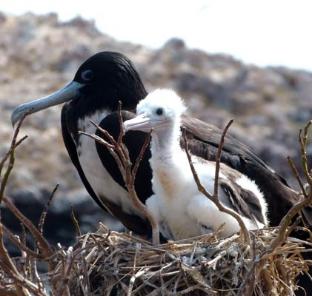Published in the Ocean Watch column, Honolulu Star-Advertiser © Susan Scott
November 19, 2012

A magnificent frigatebird mom and her chick in Isla Isabela, Mexico.
Today and for the next few weeks, I’m writing from my sailboat, Honu, currently moored in a marina in Mexico’s Banderas Bay, famous for humpback whales, tropical fish and national park islands loaded with seabirds.
From Honolulu the journey here is a long haul with a plane change on the West Coast, another three-hour flight to Mexico and the usual customs rigmarole for a foreigner lugging a suitcase full of sailboat gear. By the time my taxi arrived in the marina, I was so tired, I wished I had stayed home.
Then I looked up. Overhead, like a flock of tuxedoed maitre d’s, hovered 100 or so frigate birds, their black bodies so starkly outlined against the brilliant blue sky that they could have been cardboard cutouts. “Right this way, madam,” they seemed to say as they glided over the mast tops. “Your sailboat is waiting.”
Frigate birds are far more common along the shorelines of Banderas Bay than on Oahu’s coasts, because here the seabirds nest on islands only a few miles offshore. Most of Hawaii’s frigate birds nest in our distant northwest chain.
Mexico’s magnificent (their common name) frigate birds are a different species from those found in Hawaii, called great frigate birds, or iwa, but the distinctions are so small they’re hard to see.
Both magnificent and great frigate birds have wingspans of at least 7 feet across. Their bodies are about 3 feet long, including two tail feathers that look like a pair of scissors.
Most of those bodies are feathers. Frigate birds have the longest wingspan-to-body-weight ratio of all birds, adults weighing only 2 to 3 pounds.
Frigate birds have other qualities unlike all other seabirds, such as nonwebbed feet with long toes. The feet grip tree branches and manmade rods and bars well, but frigate bird legs hardly deserve the name legs. So short and stubby are these appendages that there’s no room to fasten the aluminum bands researchers commonly use for wild bird identification.
It’s their uncommon physical qualities that give frigate birds such extraordinary flying abilities, but they come with a price. The birds can neither walk, swim nor take off if they are accidentally grounded.
I have had the great privilege of rescuing several stranded frigate birds. Each time I touched a frigate bird’s body, my hands sunk an inch or two into black fluff, and my fingers closed around a bag of delicate-feeling bones covered with little flesh. Also each time, the bird seemed to know I was there to help, and made no attempt to bite me with its sharp hooked beak.
I lifted the animal from the ground and let it stand on my hands in the wind. The frigate bird spread its wings, rose as if on a string and soared off.
The flock of frigate birds riding the thermal winds over the marina reminded me of the joy I had felt in holding those majestic — and trusting — birds in the palms of my hands.
My outlook about being back on my boat so close to Mexico’s island seabird sanctuaries was about to change. My feelings would match the names of the seabirds I so love: great and magnificent. As soon as I had a nap.
©2012 Susan Scott